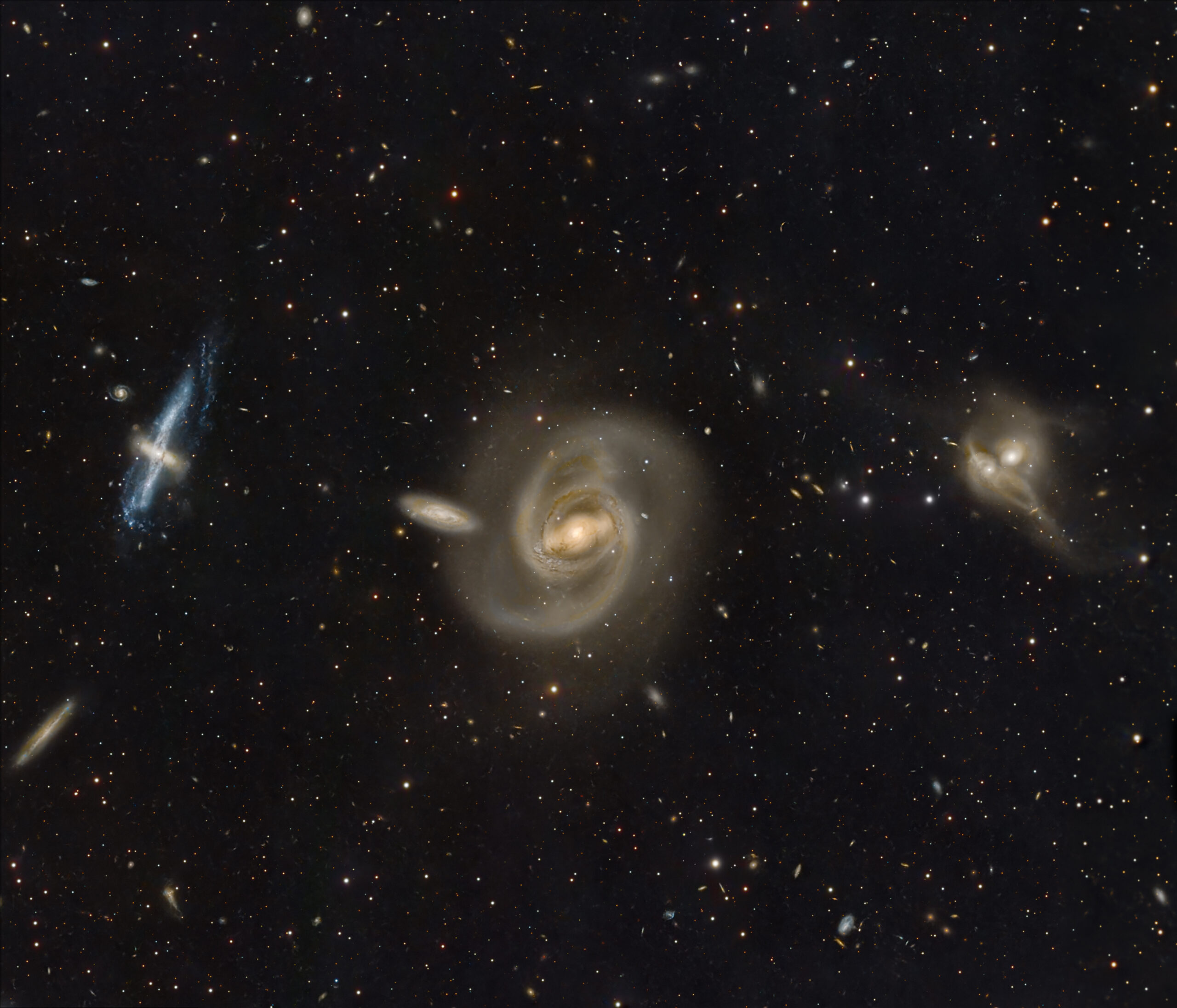
A barred spiral, a rare polar ring, and an emerging merger — a cosmic ballet 137 million light-years away.
This very diverse set of galaxies spans approximately 17 by 13 arcminutes and is centered around NGC 4650 in the constellation Centaurus.
NGC 4650 is a bright barred spiral galaxy located about 137 million light-years away. It spans roughly 2.7 by 1.3 arcminutes in the sky, corresponding to an actual size of approximately 107,500 by 51,750 light-years. The galaxy shows a strong central bar and tightly wrapped arms but does not exhibit signs of tidal interaction with nearby systems. Despite being a spiral, NGC 4650 appears relatively pale in color, suggesting a dominance of older stars and a lower level of recent star formation, along with some color extinction due to dust.
To the left of NGC 4650 lies PGC 429211, a small edge-on spiral galaxy about 133 million light-years away. It measures around 0.7 by 0.2 arcminutes, corresponding to about 27,900 by 8,000 light-years, and appears thin, isolated, and undisturbed.
Further to the far left is PGC 42951, also cataloged as NGC 4650A, a striking polar ring galaxy located at a similar distance of 137 million light-years. It spans about 1.1 by 0.6 arcminutes, or roughly 43,700 by 23,800 light-years. PGC 42951 displays vibrant blue tones along its extended ring structure, indicating vigorous ongoing star formation. Unlike most polar ring galaxies, where the central body is typically a featureless spheroid, PGC 42951 has a disky, flattened central galaxy, making it an exceptionally rare example of a transitional polar disk system. The polar structure is massive, rich in gas, and nearly as substantial as the host galaxy itself, suggesting it formed through a major merger or a unique process of gas accretion rather than simply capturing a small companion. Its complex structure makes PGC 42951 one of the best-studied and most remarkable polar ring galaxies known.
Near the bottom left of the frame is PGC 42961, another slender edge-on spiral approximately 140 million light-years away. Its apparent size of 0.9 by 0.2 arcminutes translates to a real size of about 36,000 by 8,000 light-years. It remains undisturbed and shows no signs of interaction.
To the right of NGC 4650 are the galaxies PGC 42845 and PGC 42852. Located at a similar distance of about 137 million light-years, they span a combined apparent size of 1.2 by 0.8 arcminutes, corresponding to an actual extent of approximately 48,600 by 32,400 light-years. These two galaxies are clearly interacting, with PGC 42845 showing strong tidal distortion and asymmetry, while PGC 42852 remains relatively compact but connected by faint tidal material. Morphologically, PGC 42845 appears to be a distorted barred spiral galaxy, while PGC 42852 seems more compact, possibly a dwarf elliptical or a small lenticular galaxy. The visible bridge and distortions suggest that these galaxies are in the advanced stages of gravitational interaction and may eventually merge into a larger, more massive system.
Beyond these primary galaxies, the field reveals an abundance of fainter background galaxies. Many of these appear red or yellow, indicating older stellar populations or cosmological redshift effects.
Subtle tidal structures, such as faint shells and halos around NGC 4650, hint at past merger activity. The differences in galaxy color across the field are striking: while PGC 42951 glows with youthful blue light from active star formation, NGC 4650 and several others display pale or golden tones, consistent with mature, less active stellar populations.
The total region shown in this image covers roughly 680,000 by 520,000 light-years.
Imaged in LRGB on my Planewave CDK 1000 at Observatorio El Sauce, Chile.
Image acquisition and processing: Mike Selby